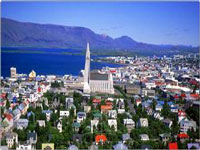 Reykjavik OverviewBack in the first century AD, legendary Viking Ingolfur Arnarson
named the settlement he founded on a northerly Atlantic peninsula
Reykjavik, meaning 'Smokey Bay'. The smoke he found wafting over
the area, however, had nothing to do with pollution, but rather the
bubbling, boiling natural geysers and geothermal springs that now
underlie the modern capital of Iceland. This source of heat and
water has ensured that Reykjavik has no need to burn fuels to warm
its heart, and the crisp, clean air is as beguiling as its clear
blue skies. The sky is not always blue, however: the city receives more than
its fair share of rainy weather blown in from the sea, and during
the long, bleak winter its northern latitude ensures that the sun
makes no more than a brief appearance every day. Despite this, the capital of Iceland is definitely a hot spot,
renowned for its lively pubs and clubs, which draw hundreds of
merry-making visitors, particularly during the long, light, bright
summer nights. Its growing reputation as a fun tourist destination
is enhanced by its fiery, friendly inhabitants, relaxed pace of
life, many cultural attractions and dozens of opportunities for
fascinating day trips, not to mention the novelty of bathing in one
of the steamy public geothermal swimming baths. Reykjavik's setting on the southwest corner of Iceland on
Faxaflói Bay is another draw card. All around are panoramic views
of the majestic Mount Esja, which rises up behind the bay, and
vistas across the Atlantic as far, on a sunny day, as the
crystalline Snaefellsjokull glacier to the west. The city has a small-town atmosphere, its centre easily explored
on foot, the quaint whitewashed wooden buildings and colourful
houses interspersed with plenty of open space. Even those who come to indulge mainly in the hedonistic
nightlife cannot fail to leave Reykjavik feeling refreshed and
rejuvenated. |